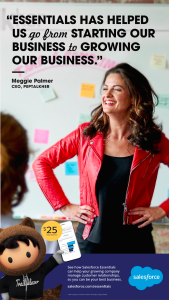Launched in November 2017, Salesforce’s Essentials solution for small businesses is coming up on its second birthday. As a replacement for Salesforce’s prior patchwork of disconnected small business apps, Salesforce designed Essentials to provide small businesses with integrated CRM solution (built on its flagship Lightning platform)—and to supply Salesforce with a more competitive entry into the small business market.
Skeptics have questioned Salesforce’s commitment to this market from the get-go. But as I discussed in this earlier post, Salesforce has been increasing its investments in Essentials product, marketing, and service capabilities—and this trend has continued since then.
Dedicated Small Business Organization
Perhaps most notably, Salesforce announced a dedicated business unit for Essentials in August 2018. As a separate business unit, with its own product, sales, marketing, and customer success teams, the Essentials organization can focus exclusively on small business requirements.
The team quickly corrected some of the early gotchas in its go-to-market strategy, expanding the prior 5-user maximum for Essentials to 10 users. Since many small businesses have more than 5 employees—and since competitors don’t have a similar user limit—this added flexibility was a must.
Essentials also initially required small businesses to sign up for an annual contract. But as an independent business unit, the team decided to add a monthly pay-as-you-go pricing option—another must-have for cashflow constrained small businesses.
As the team learned more about small business requirements, they also added several new Essentials services to help users get productive more quickly, such as:
- Choose Your Trial allows select a trial experience tailored to their needs.
- Trailhead integration with Essentials helps users through the trial set up and to continue learning.
- Essentials coaches, who help with onboarding.
- In-app support.
 And, they embarked on a broadscale marketing campaign for Essentials, including online, radio, airplanes, and billboards in cities across the country.
And, they embarked on a broadscale marketing campaign for Essentials, including online, radio, airplanes, and billboards in cities across the country.
Solution Innovation
Salesforce rolled out Sales Cloud Essentials at the initial launch, and introduced Service Cloud Essentials just a few months later. In Winter Release ‘19, the company added other new capabilities, including:
- A pilot for Einstein Voice Assistant, which enables users to verbally log updates via Salesforce’s mobile app, and to find records, update files, create follow up tasks, and send notifications. This capability will be generally available later this year.
- Campaign Management, which enables users to create and monitor targeted email marketing campaigns.
- Help Center, which enables small businesses to create self-service support sites for their customers.
The most recent updates, announced for the Summer ’19 release, center on making it easier for small businesses to engage with customers and prospects. Companies can create new chat and social channels for chat, Facebook, Instagram, YouTube and phone through a guided set up.
For instance:
- If your business uses Facebook, you can authenticate your page, and add it as a social channel. When customers message you on Facebook, you can message back from the Essentials interface.
- You can now enable live chat on your website by embedding a snippet of code from Essentials on it. This creates a chat function on your site for customers, and again, you can reply via your Essentials interface.
- The new Lightning phone dialer, which allows you to initiate, answer and log call details directly to Essentials.
 These capabilities make it easier to gather, organize and manage all of your channels in one place.
These capabilities make it easier to gather, organize and manage all of your channels in one place.
Perspective
Small businesses put ease of use at the top of the list when selecting a solution.
But “easy” is easier said than done. Time is the most precious commodity in most small businesses. They need solutions that are simple to set up, work right away, and provide what they need quickly. And when they hit a speed bump, they need to get answers quickly and easily.
Since launching Essentials, the team has been learning more and more about small business. They are applying what they learn to make the solution easier and to add more of the capabilities that small businesses need.
While Essentials has made great headway, it still has some work to do on the easy front. Although the trial experience has improved, it should be more intuitive. Navigation in the product could also be improved, both to help users do more in the solution, and to get things done more easily.  Since small business owners and employees are increasingly working out of the office, Salesforce will also need to beef up mobile capabilities.
Since small business owners and employees are increasingly working out of the office, Salesforce will also need to beef up mobile capabilities.
The Essentials team also faces some bigger decisions—specifically in terms of marketing and ecommerce capabilities. Today, it is partnering with MailChimp for email marketing, but doesn’t have an ecommerce partner. Should it adapt functionality from Marketing Cloud and Commerce Cloud solutions to give Essentials this functionality—or continue on a partnering track?
That said, the Salesforce Essentials team has its listening ears on—as evidenced by the many steps it has already taken to improve both the product and experience to date. This bodes well for Salesforce to stay on track and continue its progress towards providing small businesses with both the ease of use and the capabilities they need in a CRM solution.
© SMB Group
Source: Laurie McCabe’s Blog
